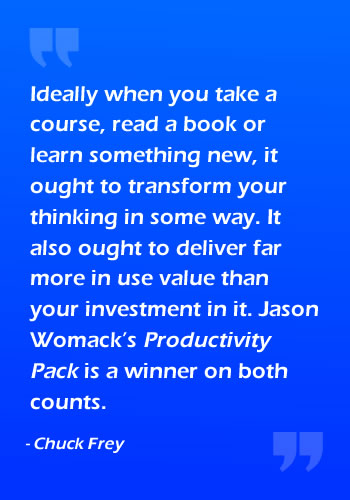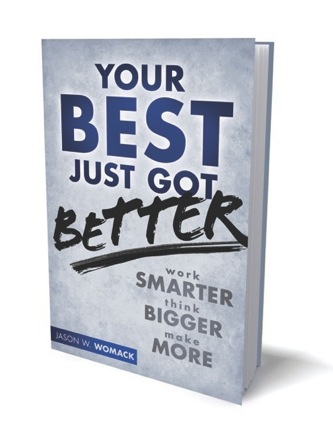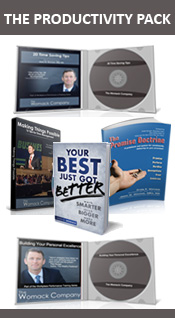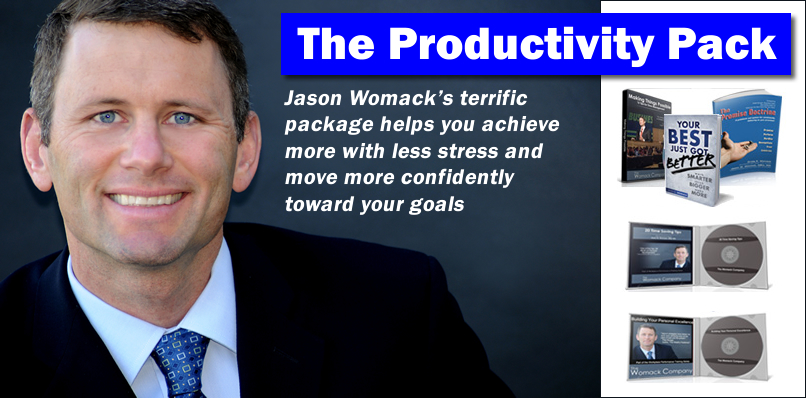If you’re looking for practical strategies to help you be more productive and successful in your work and life, then you ought to take a look at The Productivity Pack offered by author and speaker Jason Womack. This powerful “productivity kit” can help you achieve more with less stress and to move more confidently toward your goals.
The Productivity Pack is ideal for any leader, entrepreneur or executive who wants to achieve more, but is already overwhelmed by too many priorities and not enough time to address them, much less get better organized and productive. It’s filled with thought-provoking exercises that will help you to assess your current mindset and habits, and to develop better ones that help you be more focused, productive and creative.
 I’ve been reading books and articles on success, productivity and creativity for over 30 years. During that time, I’ve encountered some astoundingly good advice but also a substantial amount of recycled, “feel good” crap that doesn’t really help anyone be more effective in their work and life. So when I started to work my way through the materials in The Productivity Pack, I did so with a high level of skepticism.
I’ve been reading books and articles on success, productivity and creativity for over 30 years. During that time, I’ve encountered some astoundingly good advice but also a substantial amount of recycled, “feel good” crap that doesn’t really help anyone be more effective in their work and life. So when I started to work my way through the materials in The Productivity Pack, I did so with a high level of skepticism.
I needn’t have worried. Womack comes at his topic with a level of clarity and practicality that is refreshing, and he provides thought experiments and exercises to help you begin to think about your work, your habits and your potential in a new way. Despite the fact that I’ve been reading about this topic for three decades, I still found plenty of great ideas and things to think about that I hadn’t heard before, and which are challenging me to rethink the way I approach my work.
The Productivity Pack contains these resources:
- Your Best Just Got Better: Work Smarter, Think Bigger and Make More, Womack’s popular book on building a better mindset and habits to become more productive
- The Promise Doctrine: A Guidebook & System for Consistently Delivering on Your Promises, a workbook and poster that helps you make and keep life’s big commitments
- Making Things Possible, a training DVD that teaches 15 of Womack’s best tips for time management
- Building Your Personal Excellence, an audio CD that takes a higher-level view of the principles of productivity
- 20 Time-Saving Tips, an audio CD that is filled with savvy tactics that surprised and delighted me
Throughout the books, CDs and DVD, Womack shares stories and experiences that do a great job of illustrating his points and which help the reader understand the thinking behind the mindset, approaches and techniques he recommends. He also challenges you to try different thought experiments that help you understand your motivations and habits and to envision more productive and satisfying alternatives to your current approaches.
One of the things I appreciate about Womack’s mindset is that he thinks a lot like I do: First, he recognizes the critical and central role that creativity plays in being productive and successful. That’s why he invests time talking about tools and techniques for capturing ideas when they strike you. He’s also focused on the intelligent use of tools and technology to help increase focus, productivity and enable us to accomplish more. That has been a big theme in my life and work – technology not as an end unto itself, but as a multiplier of effort.
Womack’s ideas are often stunning in their simplicity and clarity, and take into account the level of distractions we face in today’s highly-connected world. For example, he recommends that users of Microsoft Outlook, the ubiquitous e-mail, calendar and task management software program, change the first screen they see from their inbox to a customized view of its calendar. This provides a higher-level view of your priorities, the key meetings and projects you really need to focus upon and prepare for. This “dashboard” can give you a higher level of energy that can carry you throughout your work day.
Let’s take a closer look at each of these items, and I’ll explain why they’re worth your investment.
The book: Your Best Just Got Better
 In Your Best Just Got Better, Womack helps readers build and sustain habits that lead to greater productivity. This excellent book is full of practical wisdom that you can put to work immediately.
In Your Best Just Got Better, Womack helps readers build and sustain habits that lead to greater productivity. This excellent book is full of practical wisdom that you can put to work immediately.
In contrast to the typical book about productivity or success, which tends to focus on “do these 20 things and you’ll be unstoppable” or some proprietary framework the author has invented, Womack takes a deeper, more introspective approach that takes into account human psychology – how we develop deeply-ingrained habits that may not be serving us well any more, and the steps we need to change them. Womack is his own biggest experiment; he is constantly learning, trying out new approaches and experiences, keeping what works and monitoring the results. He describes himself as being on a 17-year quest to uncover the best productivity principles – not so you can cram more work into less time, but so that you can more confidently set and focus upon your bigger life and career goals.
Some core concepts that really resonated with me included these:
Envision your ideal day: Open up your journal and invest 15 minutes writing a rich, detailed scenario of what your perfect day would look like. “Write about that portion of the day when you know you have a lot of energy and do your best work… Pick the time of day when you could be at your best.” Womack encourages the reader to focus on, write down and review what that would look, sound and feel like. This thought-provoking exercise is designed to help you envision what’s possible in your life. Not that you will ever have a day exactly like that, but it can inspire you to move in a direction where many elements of your ideal day could be possible.
I’m at my best when… This is an exercise that Womack recommends you utilize to start your work day. To do it, you get a blank sheet of paper and write, “I’m at my best when…” Then write down 5-10 things you can do to support yourself in having a good day. He emphasizes that you should focus upon things that are within your control. This simple exercise forces you to recognize and acknowledge your habits and routines, and set goals for what needs to be improved or transformed. That’s not to say this type of personal change is easy. But identifying what your ideal state should look like is a solid first step to a more productive and fulfilling life.
Womack recommends that you place your “I’m at my best when…” list in a prominent location within your workspace. Review it each morning, and make a commitment and effort to bring these new behaviors about. Doing so on a daily basis is an excellent first step toward developing new, more productive habits.
Always Be Ready: Womack looks at a typical day as a collection of 15-minute increments, discreet time blocks that we can use productively, if we’re prepared to do so. I’m sure you’ve had occasions where a meeting was supposed to start at a certain time, but a key person was running late, due to another meeting running too long. What can you do with this “down time” that has suddenly opened up? If you’re Jason Womack, you:
- Write thank you cards to clients
- Make phone calls to set up future trip arrangements
- Listen to your voice mail messages
- Use your smartphone to send e-mails to your office and clients
- Jot down or mind map ideas for an upcoming project
- Review materials for another project you’re working on
- Read articles you have clipped from magazines
Womack coaches all of his clients to always have their to-do list handy, along with materials for capturing ideas and next steps – so when you face delays, you can put that 10-15 minutes of “dead time” to highly productive use.
Invest time organizing for the week: Womack says if you waste time looking for items, such as printed forms, e-mails, electronic files and other information, then you need to update or upgrade the context in which you work: “If you only invest 30 minutes a week, perhaps in two 15-minute sessions, organizing, returning, recycling and trashing items in your workspace, you will enjoy a return on that time two- or threefold next week.” In other words, make an appointment to organize your workspace and materials – put it on your calendar as a weekly priority, and stick to it.
Building Your Personal Excellence (Audio CD)
This one-hour set of audio lessons takes a strategic, higher-level look at ways to be more productive. Each of 13 segments is 5-7 minutes long, so they are easy to consume while commuting in your car. Topics include:
- Finding and using your “lost time” to be more productive
- Getting control of your workflow
- Building a reminding system
- Journaling your way to success
- Continuous learning
It also contains a wealth of excellent, thought-provoking material that you can listen to while doing other activities. I ripped it into MP3 files and listened to it while I was walking at the track of the local health club. This was a perfect opportunity to consume new ideas and insights and then to think about how I plan to apply them to my life and work.
20 Time-Saving Tips (Audio CD)
Compared to the first CD, this one is much more tactical. When I popped this CD into my laptop, I thought I could just listen to it while doing other work early one morning. I was convinced that I had already heard most of these ideas before, and that I just had to listen for new ideas I could adopt. To my surprise, the tips Womack shared throughout this disc were so good I was compelled to open up Evernote and take notes about what I was hearing.
The ideas on this CD are pure gold and are worth the cost of the entire Productivity Pack. Think I’m exaggerating? What is your hourly worth to your employer or your own business? If you’re a mid-high level executive, your effective hourly rate probably begins at about US$75 per hour and goes up from there, potentially to several hundred dollars per hour. Even if you save only a few hours from what you learn from this CD, the entire program will pay for itself – and then some. My guess is that you’ll save far more than that, based on what I learned while listening to it.
Making Things Possible (DVD)
This DVD offers 15 tips for time management, and covers some of the same topics as the audio CD does. It is a video of a 2008 speech Womack gave to a large group. As such, it is a good summary of Womack’s best time-saving tips. It also includes a helpful workbook that summarizes the key points from each lesson on the disc – but it also provides exclusive access to some additional resources.
For example, in the chapter entitled “Set Up Your Dashboard,” Womack provides a link to a special website where you can view a 5-minute video specific to the version of Microsoft Outlook you use. In it, he demonstrates how to set up this powerful program to help you get a more productive context on your day – before you dig into the morass of the inbox. By signing up for his e-mail list, you also get a series of e-mails that provide additional tips and tweaks for getting more out of Outlook. Once again, Jason has figured some things out about this popular program that left me going, “Wow – you can do THAT?”
The Promise Doctrine: A Guidebook & System for Consistently Delivering on Your Promises (book)
This 78-page book, written by Jason and his father, Craig Womack, helps you understand what you have committed and said “yes” to, and enables you to “Do what you say you’re going to do, when you say you’re going to do it.” According to the authors, “This philosophy encourages achievement, honesty and teamwork in all areas of life and work.” They truly believe that personal responsibility is the cornerstone of sustainable achievement. Where this guide comes in most useful is in teaching you a way to document, manage and follow-up on the bigger, long term promises you want to make.
The Womacks wrap a deeper context around personal goal setting. Implicit in each goal you set is a set of promises – to yourself, your family, your boss and others – that says you’re going to do something. Consistently keeping the promises you set builds trust and sets you apart as a person of integrity whom these key stakeholders can count on. It also gives you energy and focus to pursue your deepest goals and aspirations.
To call it a book is actually to do The Promise Doctrine a disservice. Yes, it teaches you a psychology and a system for keeping your promises. But it is actually a workbook, with space for notes and simple instructions on how to create your own “Promise Guide” spreadsheet, It also contains a fold-out, pull-out poster you can pin up in your cubicle at work or in your home office. In the back of the book, another foldout contains a Promise Guide form that you can photocopy and use. You can also download an electronic copy of this spreadsheet from The Promise Doctrine website. It is available in two versions for Excel – one with macros enabled and the other one (supposedly for Mac users) with them disabled. I couldn’t get the macro-enabled version to open, but the “Mac” XLS file opened just fine and looks great.
One of the other elements of this book I really like is the “mindsweep” technique, in which you quickly make a written inventory of all of the things to which you have said “Yes” or to which you have made commitments. The authors even provide a two-page worksheet where you can record your list, The Womacks also provide a helpful list of areas of focus you should consider, which serve as helpful catalysts to get you thinking about your commitments.
Why is a book like The Promise Doctrine important? Because, if you’re like most people, events in your daily life often threaten to pull you off course to tackle urgent but not important tasks, while neglecting your longer-term promises and plans. The authors emphasize that in order to achieve exceptional results, you need to become more organized and systematic about your goals and promises. This remarkable book is a quick read and an ongoing resource, which you can use to become a person of greater integrity and achievement. It’s the ideal size for companies to distribute to their employees to help build a culture of greater accountability.
My assessment of The Productivity Pack
 Ideally when you take a course, read a book or learn something new, it ought to transform your thinking in some way. It also ought to deliver far more in use value than your investment in it. The Productivity Pack is a winner on both counts. I’m confident that it will help me to deliver many thousands of dollars in greater value to my employer and to my web business, while at the same time giving me a fresh outlook on how to get more of the right things done in less time and set and keep more of the commitments I make.
Ideally when you take a course, read a book or learn something new, it ought to transform your thinking in some way. It also ought to deliver far more in use value than your investment in it. The Productivity Pack is a winner on both counts. I’m confident that it will help me to deliver many thousands of dollars in greater value to my employer and to my web business, while at the same time giving me a fresh outlook on how to get more of the right things done in less time and set and keep more of the commitments I make.
After spending the last week doing a “deep dive” into the materials contained in The Productivity Pack, I’m thoroughly impressed. It’s obvious from reading and listening to Womack’s insights that he is a person of integrity and deep insights. Along his journey to find the best strategies and tactics to help others be more productive, creative and fulfilled, he has come across some amazing and profound ideas. He shares the best of them in an engaging, genuine style. Womack is the real deal, not a snake oil salesman who promises the sky but fails to deliver. He delivers on his promises – and then some – and you, the reader, listener and learner, benefit!
In short, I believe The Productivity Pack is an excellent investment, and I highly recommend it.
The Productivity Pack is available from Jason Womack’s website.

